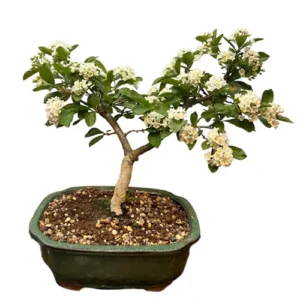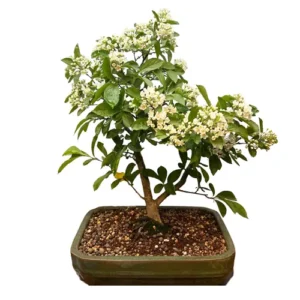Corylopsis
Winter Hazel Bonsai
Native to the woodlands of Japan, China and Taiwan. This species of deciduous shrub is adorned with toothed, ovate rich green leaves. Its aesthetic dazzle comes from its pendant clusters of bell-shaped aromatic yellow flowers that come through in Spring.
Winter Hazel Bonsai Care Tips
Placement
Place your Winter Hazel in an outdoor location that provides full sun and some partial shade for the hottest period of the summer. This species is fully hardy but be vigilant for protecting the plant in the event of late spring frosts.
Watering
Water your Winter Hazel moderately throughout the growing season ensuring that the rootball is kept moist and never dries out. During the summer this bonsai can be watered daily.
Feeding & Fertilising
Feed your Winter Hazel every fortnight throughout the growing season. Use an acidic feed as Corylopsis despise lime.
Pruning & Wiring
Pruning your bonsai is important not only to create or maintain an aesthetic style but to also ensure optimal health. In early Autumn, after the flowers have faded, trim back your Winter Hazel to shape. This should be cued by the new flower buds forming.
Winter Hazel is appropriate for informal upright styles in medium and extra-large plants. We recommend using wires with a thickness that matches the thickness of the branch: if the wire you choose is too thick you will damage the bark. If it is too thin, it won’t be effective.
Repotting
Repotting your tree is an important way to provide a fresh and suitable soil mix and ensure appropriate root health. Repot your Winter Hazel every 2 to 3 years after the tree has flowered. Be sure to use a soil mix that is free of lime.
Trees that are ready for repotting will require root pruning, a suitable new pot and appropriate soil mix.
When repotting, do not cut back the root mass by a large amount, and choose a well-draining soil mix that has a neutral or slightly higher PH value of 5-6 but not over 7. We tend to use a mixture of different speciality bonsai soils on our trees. Every species is different so please contact us for free soil-mix advice or to take advantage of our repotting service.
Bonsai trees aren’t only magnificent additions to an indoor oasis, they are more than capable of standing out in any garden. Many Bonsai species are incredibly hardy and withstand nature’s colder and damper turns with aplomb making them worthwhile outdoor plants. We have an extensive library of care guides for outdoor bonsai trees. It’s not about selecting the perfect bonsai, it’s about selecting the perfect bonsai for you.
Winter Hazel Bonsai - Typical Queries
How to propagate Winter Hazel bonsai?
You can propagate a Winter Hazel bonsai through seeds, cuttings or layering. Ground layering should take place in the Autumn, with air layering to be done in Spring. Greenwood cuttings in the Summer and seeds should be sown in Autumn.
Do Winter Hazel Bonsai get pests and diseases?
This species is not only easy to grow and train it’s typically untroubled by diseases or pest attacks.
Can you keep a Winter Hazel bonsai indoors?
It is not recommended to keep a Winter Hazel bonsai indoors, as it is an outdoor tree that needs full sun exposure and seasonal changes to thrive. Keeping indoors will likely result in poor growth.





















